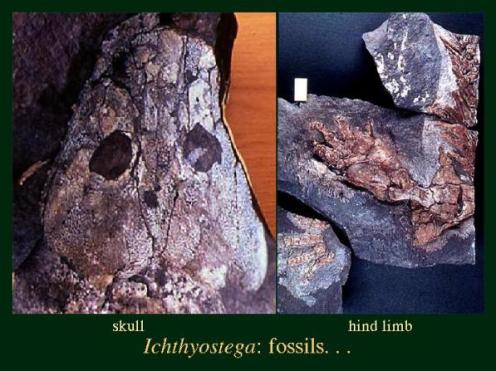 |
 |
 |
 |
 |
Produced
by the Population Genetics and Evolution class, Furman University |
||||
 |
 |
 |
 |
 |
Produced
by the Population Genetics and Evolution class, Furman University |
||||
 |
The
Devonian: Ichthyostega |
 |
||
| Ichthyostega
were the first known tetrapods studied from the Devonian period (DevonianTimes
2006; Wikipedia 2010). Ichthyostega was a “labryinthodont”,
which is a clade of vertebrates intermediate to fish and amphibians (Wikipedia
2010). Even though it is not considered to be a true amphibian, it does
posses key similarities (Wikipedia 2010). Specifically, it possessed lungs
and limbs, which allowed it move efficiently through shallow water and
onto land. These four-legged animals were found in fossils in eastern
Greenland. The basic morphology of these animals are very similar to modern
day tetrapods. They were approximately 1m in length and possessed a small
dorsal fin along its tail (Encyclopedia Britannica 2006). Interestingly,
the series of bony supports found in the tail are also found in fishes
(Encyclopedia Britannica 2006). In fact, there are many similarities between
Ichthyostega and early aquatic vertebrates including: short snout
region, presence of preopercular bone in the cheek region (gill cover
in fish), and small scales on the body (Encyclopedia Britannica 2006).
It also shares many traits with tetrapods including: walking legs, robust
bones, a lack of gills, and strong ribs (protection of lungs) (Devonian
Times 2006; Encyclopedia Britannica 2006). Ichthyostega and its
relatives “represent forms slightly more advanced than the aquatic
Eusthenopteron and appear to be near the evolutionary line leading to
the first tetrapods on land” (Encyclopedia Britannica 2006). Page by Matt Medlin |
  |
| Picture 1: Ichthyostega fossil; skull and
hind limb. From: Scienceblogs.com Picture 2: Model of Ichthyostega. From: Marcella Gutierrez |
|
|
Curley R. 2010. Ichthyostega spp. Encyclopaedia Britannica Online.Accessed February 25, 2010. Murphy D. 2006. Ichthyostega. Devonian Times. Accessed February 2010. Wikipedia. 2010. Ichthyostega. Accessed February 2010. |